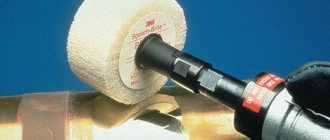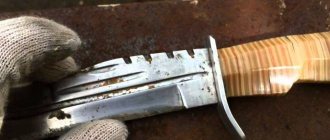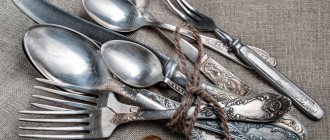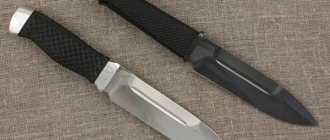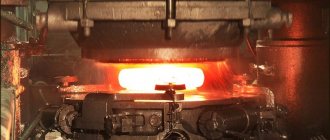Metal grinding
What is metal grinding? This technology means its processing using abrasive material. This process is carried out using a special technique and is designed to change the texture of the surface, as well as its other characteristics. Grinding is applied to the outer and inner parts of the metal (flat or cylindrical).
Metal processing characteristics:
- grinding is the final stage of metal processing, which is carried out to create roughness;
- the technology is not suitable for radically changing the dimensions of the product;
- It is possible to obtain the required degree of roughness using modern equipment after processing the workpiece under high temperature.
In the process of metal grinding, a number of features are taken into account:
- cutting depth;
- possibility of cross feeding;
- product movement speed;
- wheel speed (depending on equipment characteristics and outer diameter).
Polishing metal at home
Many home craftsmen are faced with the need to clean metal products. This could be some kind of tool (hammer, wrench), door handles, padlocks, etc. To make the product aesthetically pleasing and beautiful, it is recommended to polish metal surfaces .
The polishing process consists of the following steps:
- Cleaning rust and other surface contaminants
- Rough machining
- Semi-finish machining
- Polishing
As is clear, before direct polishing, the metal product must be prepared. Typically, the preparatory part accounts for about 70% of the work. That is, polishing itself is not the most time-consuming and labor-intensive task.
At home, it is customary to use a mechanical type of polishing. If you do not take into account the preparatory work, polishing is carried out with a soft material (felt, foamed PVC), using a special paste .
One of the most famous varieties of polishing pastes is GOI paste .
There are 4 varieties of this paste, which differ in shade, from light green to black-green. Each grade of GOI paste provides a certain degree of polishing purity.
How to remove corrosion and old paint
- Primary preparation - at this stage, the removal of oxides, traces of old paint and other surface contaminants is carried out. For this purpose, it is customary to use special cleaning chemicals.
There are universal liquids for keeping your kitchen or bathroom clean and tidy. Many products are very aggressive, which allows them to easily eat away rust, old paint and oxide film.
If you don’t have such a product at hand, then a brush with metal bristles will help out. But you can also resort to a grinder with a special attachment for primary processing of rolled metal .
Leveling surfaces
- Rough machining - at this stage, the correct geometry is restored on the edges and contact surfaces.
If we talk about a hammer, then this tool may need to align the edge of the striking penny.
For rough machining, a set of metal files is usually used. Files can be replaced or supplemented with an angle grinder with a special attachment for grinding.
Semi-finish and fine grinding
- Semi-finish machining - this stage leads closely to the final polishing process. During grinding, most of the irregularities are eliminated.
Sandpaper is used for sanding. The degree of grinding purity is determined by the class of sandpaper. If sandpaper P100-200 is suitable for rough grinding, then semi-finish sanding requires sandpaper of the P400-P600 class.
If we talk about fine grinding, which partially turns into polishing, sandpaper P1000-1200 is used for this purpose.
The grade of sandpaper depends on the size of the abrasive grains . Coarse emery P100 has a grain size of 125-160 (µm). Sandpaper for cleaner sanding P400 has an abrasive size in the range of 28-40 (µm).
Sandpaper for fine work P1000 has a grain size of 14-20 (µm).
Final polishing
- Fine finishing polishing is the final stage of processing metal products.
To finish leveling the surface layer of a metal product, exposure to an abrasive with a grain size in the range of 1 - 0.01 (µm) is required. For such fine processing, a polishing paste is needed, which should first be applied to a felt (wool or PVC) polishing wheel .
For final polishing, special wheels are produced that are already impregnated with fine abrasive paste.
Use a power tool for polishing. If a craftsman often has to do polishing, it makes sense to get a polishing machine . This equipment is very similar to a sharpening machine . There are even special polishing wheels that are suitable for use on a sharpening machine.
The polishing process is characterized by high spindle speeds, at least 800-1000 (rpm).
As a result of final polishing, the metal product acquires a mirror shine noticeable from afar.
Main types of grinding
Metal grinding is done using various methods. Technologies differ in the method of rotation (of a wheel or a workpiece), the speed of movement, as well as the side on which the grinder works (end, plane) and other factors. Main types of grinding:
- round;
- grinding of internal surfaces;
- gear grinding;
- centerless;
- flat.
Grinding methods are also classified according to the type of material used in the processing. To transfer the process to automatic mode, special machines or a built-in CNC unit are used, which reduces labor costs and ensures high quality products.
Cylindrical external grinding
Cylindrical grinding is the most popular method. It is not only external, but also internal. The circular method is carried out due to the synchronous rotation of the circle and the metal part. External grinding provides a cutting effect, and internal grinding provides uniform work.
Among the features of cylindrical grinding are:
- the abrasive wheel is a consumable material, it rotates around its own axis;
- the metal part rotates synchronously with the circle (this increases the efficiency of the process);
- Both longitudinal and transverse feeds are carried out (due to them, the depth of infeed changes and processing is ensured along the entire length).
This technology is suitable for processing cylindrical products, since when the circle comes into contact with a cylindrical product, the entire surface is processed.
Internal grinding
Internal grinding is similar to circular grinding, but differs in that the abrasive wheel is located inside the metal workpiece. Distinctive features of the technology:
- longitudinal and transverse feed can be carried out;
- the main rotation is provided by the abrasive wheel.
To increase the efficiency of the method, coolant is used. It is fed into the cutting zone.
Gear grinding
Gear grinding is a process that is carried out using gears. Hence the name. The complexity of the method lies in the fact that it is necessary to use technological equipment for grinding. Distinctive features of gear grinding:
- special machines are used for work;
- the circle is adjusted to the size of the tooth involute;
- the ring gear is processed.
The tooth surface is hardened, which can make machining the workpiece more difficult.
Centerless grinding
Centerless grinding is different in that the metal part is not fixed. The workpiece is placed between two grinding wheels that rotate. There is a stainless steel knife in the center, which eliminates the possibility of the product moving or jamming slightly.
Since the method involves the use of two grinding wheels at once, the process is much faster. Centerless grinding is carried out using special machines.
This technology is only possible in production workshops, and not at home.
Sanding flat surfaces
Flat grinding is one of the simplest technologies, since it is carried out only by the movement of abrasive nozzles, without rotation of other elements. This method is used for the manufacture of presses and other flat products. The technology used has its own characteristics:
- the metal workpiece is placed on a special table and securely fastened to it mechanically or using a magnet;
- the workpiece is mounted on an electromagnetic table or using machine tools;
- The main movement is taken over by abrasive attachments.
Thanks to this technology, it is possible to grind the most complex shapes. During operation, to increase efficiency, you can pour coolant into the contact point between the tool and the metal product.
Other metal grinding methods
There are also other, less common metal processing methods:
- Peeling – erasing the top layer if it has been damaged during use. After this, another sanding method must be used.
- Profiling is the most difficult technology, which involves working with a curve or broken line. This is the general name for gear grinding, thread grinding and spline grinding.
- Finishing – grinding, which is used to achieve shine and a polishing effect. This technology removes scratches and stains from the surface of the product.
What methods of metal polishing exist?
You can remove roughness and get a mirror-smooth metal surface in various ways. The following polishing methods are available:
- Abrasive (mechanical)
- Chemical
- Electrolytic
- Ion plasma
Of course, the main polishing methods have their own subtypes that correspond to certain specifics of metalworking.
- Mechanical polishing is the most common metalworking method. For mechanical impact on the workpiece, a finely shaped tool or substance (paste) is used.
Mechanical polishing is divided into the following subtypes:
- Hand polishing
- Machine polishing
Manual mechanical polishing uses hand tools and devices. But it is also acceptable to use hand-held power tools: an angle grinder, an angle grinder or a grinder with a set of special heads for polishing.
Machine polishing involves the use of a special polishing machine. Such equipment often has a high degree of automation. While hand polishing is more suitable for one-off production or repair, machine polishing is used in serial and mass production.
Mechanical polishing often uses waterjet technology . As with machining, waterjet polishing is typically performed as part of high-volume or mass production.
How to polish using chemical solutions.
- Chemical polishing involves the use of acid solutions. When polishing metal with acid, the top layer dissolves. This allows you to smooth out micro-irregularities and make the surface shiny.
Additionally, during the process of chemical polishing, the oxide film is passivated , which significantly slows down the corrosion process.
For chemical polishing of metal, a solution of sulfuric, hydrochloric and nitric acids is used. In some cases, sodium chloride and salts of various metals are added.
It is rational to use chemical polishing only in large-scale and mass production.
- The chemical polishing process can use galvanic steam. This process is called electrolytic polishing . The presence of electric current makes it possible to significantly speed up the polishing process and improve the quality of the final result.
Not only acid, but also alkalis and even saline solutions can act as an electrolyte.
This technology is used for both polishing and etching of metal .
What other types of polishing exist?
- Ion-plasma polishing - this technology allows you to remove the top layer of metal due to the targeted effect of ions and plasma.
Ion plasma polishing is used in the production of components for microchips.
Processing parts before grinding
Metal grinding is the final stage of processing, and it requires preliminary preparation. Before the process, it is necessary to process metal parts in several stages:
- Rough turning of the workpiece. At the first stage, the workpiece is given the required shape and dimensions, taking into account the allowance.
- Finish turning of metal. The workpiece is processed to the required size.
- Milling. This technology involves removing the workpiece mechanically. Milling is most often carried out on housing parts and gears.
- Metal processing under high temperature. The workpiece is hardened in order to significantly increase the hardness and strength of the surface. Annealing and tempering reduces the fragility of the product. In some cases, during the heat treatment process, certain chemicals are applied to the surface layer.
The Cherepovets metal structures plant has been working for you for more than 55 years. We design products, then manufacture them in our own workshops and deliver them throughout Russia. To order, call 8 or order a call on the website.
Application area
Small metal parts are used in enterprises engaged in the production of:
- cars and trucks,
- agricultural machinery,
- engines and transmissions,
- oil and gas equipment,
- hydraulics,
- medical equipment.
There are metalworking enterprises that produce various parts to order and provide services for their processing and modification. In everyday life, grinding and polishing is required during car repairs and during construction work.
